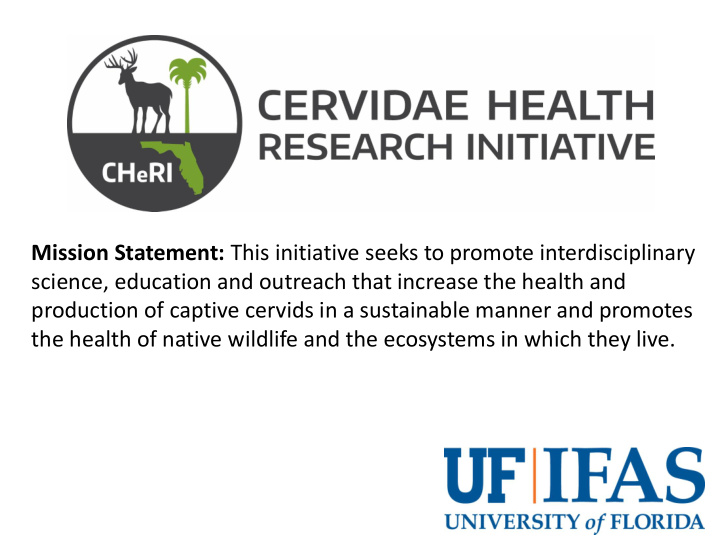



Mission Statement: This initiative seeks to promote interdisciplinary science, education and outreach that increase the health and production of captive cervids in a sustainable manner and promotes the health of native wildlife and the ecosystems in which they live.
Who we are: Director • Samantha Wisely, Wildlife Ecology and Conservation CHeRI Affiliate Scientists • Jason Blackburn, Geography • Nathan Burkett-Cadena, Florida Medical Entomology Lab • John Lednicky, Environmental and Global Health • Katherine Sayler, Wildlife Ecology and Conservation • Tom Waltzek, Pathobiology • Jim Wellehan, Zoo Medicine Program
Current Projects: • Best Management Practices to Curb Hemorrhagic Disease • Pathogens and parasites shared by livestock and cervids • Risk assessment and disease prevention for Parelaphostrongylus spp. infection
Hemorrhagic Disease Objectives: Decrease morbidity and mortality via: • Integrated pest management • Diagnostics • Best farm management practices
Study Area
Integrated pest management: Current research objectives • Identify competent vectors of HD in Florida • Identify larval habitats of Culicoides • Work with pesticide companies on targeted delivery systems • Map distribution of Culicoides spp. and create predictive map of emergence based on climate variables
Culicoides Community Ecology • In which habitats are • LED light traps in a different Culicoides random stratified spp. found? design • In what habitats do • Larval substrate different Culicoides collection spp. develop? • Which species feed • Aspirate feeding on white-tailed Culicoides off tame deer? deer • Which vertebrate • Molecular-based species are hosts to bloodmeal analysis Culicoides ?
Site 16: Deep in forest canopy of oak hammock Site 1: At edge of improved pasture, formerly sand pit
Bloodmeal analysis results
Diagnostics: Current research objectives: • Correlate morbidity and mortality of deer with serotype and genotype of viruses • Establish library of isolates from Florida • Understand viral mechanisms underlying virulence and pathogenicity – Quasispecies, Genotype, Recombination • Role of co-infection
Wildlife & Aquatic Veterinary Disease Laboratory Diagnostics & Pathogen Discovery • Waltzek/Wellehan Conventional Diagnostic Methods (2000 – 2010) – 35 herpesviruses – 15 adenoviruses Waltzek et al. 2007, 2011 – 7 papillomaviruses – 5 poxviruses – 6 iridoviruses 3 2 1 – 6 reoviruses – 6 astroviruses – 1 coronavirus • Waltzek/Wellehan NGS (2011 – 2015) – > 100 novel pathogens (viruses, bacteria, etc.) – Highlights include: Novel Picornaviruses, Bunyaviruses, Hepeviruses, Papillomaviruses Mimiviruses, Poxviruses… – Diagnostics for OIE reportable pathogens (KHV, RSIV, Ranavirus)
Necropsy performed on 21 animals in 2015: 1 with clinical signs and gross pathology consistent with HD -17 of 21 animals were fawns -NONE of the fawns had signs consistent with EHD/BTV - One of 21 animals had confirmed HD (adult white-tailed deer buck) -Other causes of mortality included primary bacterial pneumonia, septicemia, caused by infection w/: • Arcanobacterium pyogenes • Pseudomonas sp. • E. coli isolated from kidneys • Enterobacter cloacae
Serology: BTV cELISA and EHD VNT N=81 captive cervids April- October, 2015 • 6 species were sampled: North American elk, fallow deer, black buck, Pere David’s deer, axis deer, white - tailed deer • 44% of exotics were seropositive for EHD, 33% for BTV • 77.8% of captive white-tails were seropositive for EHD, 34.2% for BTV
Questions? Comments? Suggestions? Collaborations? Please contact Dr. Samantha Wisely, wisely@ufl.edu http://www.wec.ufl.edu/cheri/
Recommend
More recommend